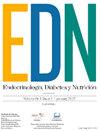Phase angle: Differences between disease-related malnutrition, obesity and healthy people
IF 1.8
4区 医学
Q4 ENDOCRINOLOGY & METABOLISM
引用次数: 0
Abstract
Introduction
Bioelectrical Impedance Analysis (BIA) is a tool used in clinical nutrition and pure electrical data such as phase angle (PA) has shown prognostic value. It relates resistance and reactance indicating cellular health.
Objective
To determine differences in PA between patients with obesity and disease-related malnutrition (DRM) compared to the healthy population, and to establish associations between PA and other body composition (BC) parameters.
Materials and methods
Retrospective observational study with 1079 patients from the Obesity and Nutrition Department of the Complejo Asistencial Universitario de León between April/2014 and August/2022 as well as 86 healthy controls. Demographic and anthropometric variables were collected and BC was performed with BIA Tanita MC780®. Diagnosis of malnutrition according to GLIM criteria and obesity with body mass index (BMI).
Results
PA50KHz in obesity group is 5.98º, DRM 4.79º and control group 6.08º. Statistically significant differences in PA between DRM and control groups, as well as DRM and obesity (p < 0.001). Weak positive correlation in total population (r = 0.452, p < 0.001) as well as control group (r = 0.463, p < 0.001) between BMI and PA. Weak negative correlation in the total population (r = −0.408, p < 0.001), DRM (r = −0.268, p < 0.001) and obesity (r = −0.342, p < 0.001) between age and PA.
Conclusions
In this study, significantly lower PA was observed in the DRM group than in the control and obesity groups. No statistically significant differences between PA in the obesity and control groups and no correlation between BMI and PA in the obesity group. More studies are needed to standardize cut-off points in different contexts and populations.
相角:与疾病相关的营养不良、肥胖和健康人群之间的差异。
简介生物电阻抗分析(BIA)是临床营养学中使用的一种工具,相位角(PA)等纯电数据具有预后价值。它将电阻和电抗联系起来,显示细胞的健康状况:确定肥胖症和疾病相关营养不良(DRM)患者与健康人群相比在 PA 方面的差异,并确定 PA 与其他身体成分(BC)参数之间的关联:2014年4月至2022年8月期间,对莱昂大学综合医院肥胖与营养科的1079名患者以及86名健康对照者进行了回顾性观察研究。研究人员收集了人口统计学和人体测量变量,并使用 BIA Tanita MC780® 进行了 BC 分析。根据 GLIM 标准诊断营养不良,根据体重指数(BMI)诊断肥胖:结果:肥胖组的 PA50KHz 为 5.98º,DRM 为 4.79º,对照组为 6.08º。DRM 组和对照组以及 DRM 组和肥胖组之间的 PA 差异具有统计学意义(p 结论:肥胖组的 PA50KHz 明显低于 DRM 组:在本研究中,DRM 组的 PA 明显低于对照组和肥胖组。肥胖组和对照组的 PA 没有明显的统计学差异,肥胖组的 BMI 和 PA 之间也没有相关性。需要进行更多的研究,以便在不同的环境和人群中统一截断点。
本文章由计算机程序翻译,如有差异,请以英文原文为准。
求助全文
约1分钟内获得全文
求助全文
来源期刊

Endocrinologia Diabetes Y Nutricion
Multiple-
CiteScore
2.10
自引率
10.50%
发文量
99
期刊介绍:
Endocrinología, Diabetes y Nutrición is the official journal of the Spanish Society of Endocrinology and Nutrition (Sociedad Española de Endocrinología y Nutrición, SEEN) and the Spanish Society of Diabetes (Sociedad Española de Diabetes, SED), and was founded in 1954.
The aim of the journal is to improve knowledge and be a useful tool in practice for clinical and laboratory specialists, trainee physicians, researchers, and nurses interested in endocrinology, diabetes, nutrition and related disciplines.
It is an international journal published in Spanish (print and online) and English (online), covering different fields of endocrinology and metabolism, including diabetes, obesity, and nutrition disorders, as well as the most relevant research produced mainly in Spanish language territories.
The quality of the contents is ensured by a prestigious national and international board, and by a selected panel of specialists involved in a rigorous peer review. The result is that only manuscripts containing high quality research and with utmost interest for clinicians and professionals related in the field are published.
The Journal publishes Original clinical and research articles, Reviews, Special articles, Clinical Guidelines, Position Statements from both societies and Letters to the editor.
Endocrinología, Diabetes y Nutrición can be found at Science Citation Index Expanded, Medline/PubMed and SCOPUS.
 求助内容:
求助内容: 应助结果提醒方式:
应助结果提醒方式:


